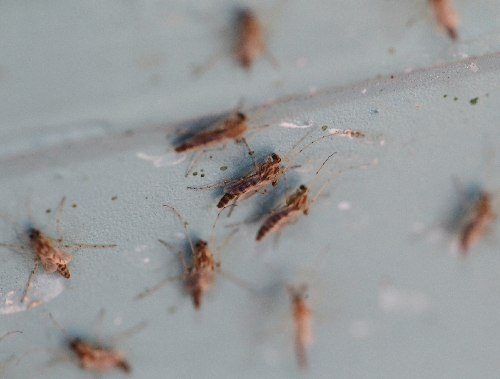Bugs find a home along now-wet Sloan Channel
Chironomid midges are small insects that swarm in thick clouds. They're annoying, but they don't present an immediate health risk. The city of North Las Vegas may soon discover what a nuisance the little bugs can be.
On July 27, acting on complaints from Sunrise Manor Township residents and firefighters at the newly opened Fire Station No. 20 at 5865 Judson Ave., Clark County pest control specialists examined the clouds of midges that were originally mistaken for mosquitoes. The insects, also referred to as non-biting midges, were traced to their breeding ground, the Sloan Channel, just downstream from the newly operational North Las Vegas Water Treatment Facility.
"It's not necessarily coming from our plant," said acting North Las Vegas utilities director Reed Scheppmann. "Our wastewater plant is different from other plants in the area, because we have covered tanks, and the other wastewater plants have open tanks."
On June 9, the city of North Las Vegas began releasing treated waste water from the $240 million plant into the Sloan Channel, which is owned and maintained by Clark County. A battle between the county and city over use of the channel was taken to federal court. An Aug. 9 decision by U.S. District Judge Philip Pro said the lawsuit raised no relevant federal issues and remanded the case to state District Court, where Clark County already has filed a lawsuit.
The county said the change from a normally dry flood channel to a constantly flowing effluent stream would result in added expenses for channel maintenance.
The midges are the first indication of the sort of expenses to expect.
County pest control officials discovered an infestation of midge larvae, called bloodworms because of their bright red color, along the channel. An initial survey of the water from Carey Avenue to Stewart Avenue revealed more than 500 bloodworms per square foot.
Two mosquito pools were recently discovered in Logandale, prompting the Southern Nevada Health District to issue a warning.
"With the identification of positive mosquitoes in one area of Clark County, it is likely that West Nile virus-infected mosquitoes are present throughout the valley," the email read. "Precautions against the disease are recommended for all residents and visitors."
While mosquitoes must have standing water to breed, midges can thrive in the shallow mud beneath running water.
"We have some midges all across the valley," said Clark County Vector Control supervisor Chris Bramley. "We don't have them in these numbers, where they're in large swarms bothering people on the walking trail and at the fire station and the senior center. This is an abnormal amount of chironomid midge production."
County specialists described the area as a perfect breeding ground for midges and expected to find them all along the nearly four-mile channel.
"Normally, natural predators would keep their numbers down," said Gary Jones, a Western Exterminator Company entomologist. "A lot of the control happens in the water when they're still in their larval stage when they're eaten by frogs, fish or lizards. The water is too shallow for any natural biological control to form."
Jones added that while there have been a record number of insects in the valley this year, due to the late summer, that wouldn't be a factor for the midges, which simply need the right water conditions.
An initial email from a pest control expert for the county stated that treatment of the midges could not be done cost effectively or efficiently, but Bramley later contradicted the statement.
"The midges can be treated, and in fact we're currently working on the situation," he said. "I've been asked to track costs. If the city of North Las Vegas gets billed, we'll have the costs of the equipment, material and man hours."
Scheppmann said North Las Vegas is open to talking with Clark County about the problem.
"My understanding is that the county is doing a certain level of activities in the channel to try to mitigate the situation," Scheppmann said. "We're certainly open to discussing with the county or anyone else any ideas they might have."
So far, the county has been working to remove the breeding mud.
"We've been driving an ATV down the channel from Carey Avenue on down," Bramley said. "It's kind of like what they do at a baseball game when they drag chains to smooth out the infield."
The process is complicated by the fact that there is no place to move the mud directly north of Lake Mead Boulevard, as water fills the channel from bank to bank from where it enters the channel near Carey Avenue. Crews are forced to move the material downstream to an area where the flow narrows and there is dry concrete on both sides. From there it can be spread out, picked up and removed.
Bramley said there are a number of treatments that would be effective in the channel, and he was currently crunching the numbers to figure out the most cost effective. He said channel dredging alone may not be enough, since the base of the channel is not perfectly smooth.
He has been examining the channel daily and has noticed a drop in the midge levels since the county began the work.
"If we can get by on just the ATV work, then the only cost would be the ATV, the employee operating it and the gas, which wouldn't be much," Bramley said. "If we have to use a biological treatment, just a guesstimate would be $9,000 to $10,000 a month for the six months or so we would have to enforce the program each year."
Vector Control is keeping an eye on the situation and is encouraging residents who live near the channel to call 455-7543 if they have any questions or concerns.
"If they have samples in their house they believe are mosquitoes, we'll come and pick them up and identify them," Bramley said. "Just pick them up with a piece of Scotch tape and put them in a baggie."
While a lot of residents near the channel are noticing the midges, not all of them are letting the insects bother them.
"We had these little bugs all over our patio Saturday (July 25)," said Roy Musgrove, who lives a few blocks from where the effluent flows into the Sloan Channel. "We didn't know what they were, but we just chased them away."
Contact Sunrise and Whitney View reporter F. Andrew Taylor at ataylor@viewnews.com or 380-4532.
b>Report Pests
Residents who think they've found mosquitoes are encouraged to call Clark County Vector Control at 455-7543.















